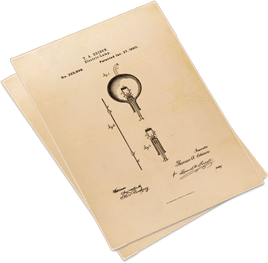In choosing the symbol that will stand for a product in the minds of consumers, all of the factors governing what may and may not be, or become, a registered U.S. trademark should be carefully considered. As a general rule, almost anything may be used as a mark (trademark, service mark, collective membership mark, or certification mark) to identify the source of goods and/or services, so that what cannot be registered (see below) may be more thought-provoking.
Registrable Marks
A trademark or service mark (generally a “mark”) that may be registered in the United States can be made up of one or more of any number of elements. Most marks consist of words. However, marks may be only letters or only numbers or combinations of letters and numbers. They may be initials or acronyms. They may be single words, phrases, sentences, slogans, or exposition. Marks may contain recognizable words in any language, or fanciful terms, or nonsense. Within certain limits, they may be or may contain names of persons or places. The text may or may not be written in a particular, stylized lettering. Marks may contain punctuation and typographical symbols used in the usual way or used in a graphical or connotative manner. Marks may also be simply designs, alone, comprised of one or more graphical elements, a logo, or they can be combinations of text and designs and include a specific color or colors.
Trade Dress
The shape of a product, or of the package in which the product is marketed, or of an element of the packaging, can also comprise a mark or an element of a mark. This type of trademark, called a configuration mark, is often referred to as “trade dress.”
A mark can also consist of just a color, just a scent, odor, or fragrance, or just sound. Perhaps the best known example of a color-only mark is the distinctive pink that distinguishes Owens-Corning insulation products. And there are any number of easily recognizable sound-only marks. For example, the familiar three tones of the NBC chimes are a registered trademark of the National Broadcasting Company, and the sound of Leo the Lion’s roar is a registered trademark for MGM motion pictures.
Marks That Can’t Be Registered:
Anything used to identify the particular source, maker, or provider of products or services traded in the market place is, by definition, a trademark or a service mark, but certain marks by their nature will not be accorded the specific benefits and protection of U.S. registration. In the first place, any mark that has not been used in interstate commerce cannot win a federal registration. In addition, trademark law specifically prohibits the registration of certain other types of marks that are best described in the words of the federal statute itself (15 U.S.C. §1052):
“No trademark by which the goods of the applicant may be distinguished from the goods of others shall be refused registration on the principal register on account of its nature unless it:
- Consists of or comprises immoral, deceptive, or scandalous matter; or matter which falsely suggest a connection with persons, living or dead, institutions, beliefs, or national symbols,
or bring them into contempt, or disrepute. - Consists of or comprises the flag or coat of arms or other insignia of the United States, or of any State or municipality, or of any foreign nation, or any simulation thereof.
- Consists of or comprises a name, portrait, or signature identifying a particular living individual except by his written consent, or the name, signature, or portrait of a deceased President of the United States during the life of his widow, if any, except by the written consent of the widow.
- Consists of or comprises a mark which so resembles [another] mark … as to be likely, when used on or in connection with the goods of the applicant, to cause confusion, or to cause mistake, or to deceive: Provided, That [some marks may meet the requirements for Concurrent Registration] or,
- … is primarily merely a surname.”


